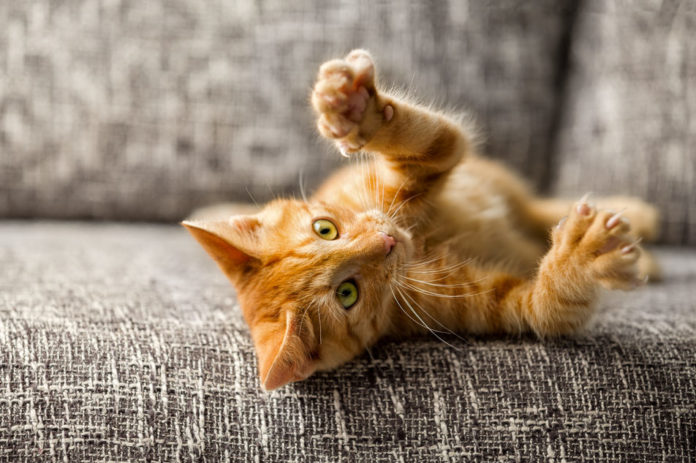The declawing ban – its time has come!

From whole countries to individual cities, a growing number of regions around the world are banning declawing.
Declawing is a hot topic in feline health. This inhumane and unnecessary surgical procedure leaves cats with negative long-term physical and behavioral issues. Unfortunately, many people still opt to declaw their cats to prevent destructive scratching. But lately, some countries, cities and other regions have banned declawing, and more are coming on board all the time.
Why declawing is so bad for cats
Contrary to popular belief, declawing involves far more nail removal. “Declawing is also known as onychectomy or partial digital amputation,” says veterinarian Dr. Margie Scherk. “The surgery is actually amputation of the cat’s third ‘toe/finger bone’. Unlike human nails, feline nails are actually part of the bone. In human terms, it would be like cutting off a person’s finger at the last joint. There are inherent risks and complications connected to this surgical procedure. Declawing also causes significant pain for cats that can last their whole lives.”
Newer studies show declawing has severe negative impact on cats, not only in terms of pain but also adverse behavior. Cats experience phantom pain in the extremities because the brain still “holds” the image of the missing part. “We do know that cats experience pain directly where the nerves were severed,” says Dr. Scherk. “In very many cases, this pain never stops…it’s like having your fingers slammed by a door, only the pain lasts forever.”
Because many declawed cats live in a state of chronic pain, they have a lower tolerance for handling and may display irritability or aggression.
Declawed cats are also more likely to suffer back pain, likely due to the permanent change in how they bear weight. Further, they may become prone to over-grooming and chewing their fur on all parts of their body, not just their toes.
Dr. Scherk adds that dclawed cats have a significantly greater chance of eliminating outside the litter box, although the exact reason is unknown. And not surprisingly, declawed cats resort to biting as their next line of defense.
Declaw bans in the US and Canada
- Many countries around the world have banned declawing surgery, rightly declaring it inhumane and unethical. To date, a total of 39 countries, including Australia, Brazil, England and Japan, have banned declawing it. “The EU has banned declawing for decades, and any veterinarian performing this procedure stands to lose their license,” says Dr. Scherk.
- Unfortunately, no US state has so far passed declaw legislation, although several have tried. In 2017, for example, the New Jersey State Assembly voted in support of anti-declaw legislation, but the proposed legislation must pass the Senate to become law.
- This doesn’t mean that declawing is still legal everywhere. In the state of California, eight cities — Berkley, Beverly Hills, Burbank, Culver City, Los Angeles, San Francisco, Santa Monica and West Hollywood — have banned declawing. Additionally, California SB 1229 makes it illegal for landlords to require tenants to declaw cats, when pets are allowed under current rules.
- Rhode Island has passed a similar bill (H 5426/S 177), which again prohibits landlords from requiring tenants to declaw cats as a rental condition.
- The city of Denver, Colorado passed an ordinance banning declaw procedures unless medically necessary. Proposed state legislation has yet to be approved.
- In Canada, Nova Scotia was the first province to declare declawing unethical, followed by British Columbia. Dr. Scherk adds that Veterinary Clinics of America (VCA), which has hospitals in five Canadian provinces, has also banned their hospitals from performing the procedure.
- Most recently, the N.L. College of Veterinarians passed a resolution against declawing in early November of 2018 – as of January 1of this year, veterinarians licensed in Newfoundland and Labrador are no longer performing declawing surgeries on cats.
Different means to the same end
Even though some Canadian provinces and US cities have passed anti-declaw legislation, the driving force behind the movement is different in the two countries. The US legislation to date was enacted by civic officials, whereas the Canadian bans were enacted by the veterinary associations of the relevant provinces.
“There is more power to the movement when it is sourced by veterinarians,” says Dr. Scherk. “We are trained to be animal advocates and promote animal welfare. It isn’t mandatory for veterinarians in the US to belong to their state associations, and the latter bodies don’t have the same legal clout they do in Canada. There are over 700 VCA hospitals in 43 states. Together with Banfield (over 900 hospitals), they could lead the way in the US. The time has come.”
Alternatives to declawing
Scratching is a hard-wired, multi-purpose, natural instinct in cats. They scratch to shed the outer husk of their nails, and to mark territory. This instinctual behavior cannot be unlearned or surgically removed through declawing. Even declawed cats will go through the motion of scratching.
- Scratching posts. Place stable, desirable scratching surfaces in locations your cat can mark as his territory.
- Positive reinforcement. Treats, catnip and pheromones attract cats to appropriate scratching surfaces.
- Regular nail trims. Nail trims reduce the damage to household furnishings and scratch injuries to people.
- Nail caps. Vinyl nail caps applied to your cat’s claws don’t hurt him, come in a variety of colors, and naturally fall off in about four to six weeks.



